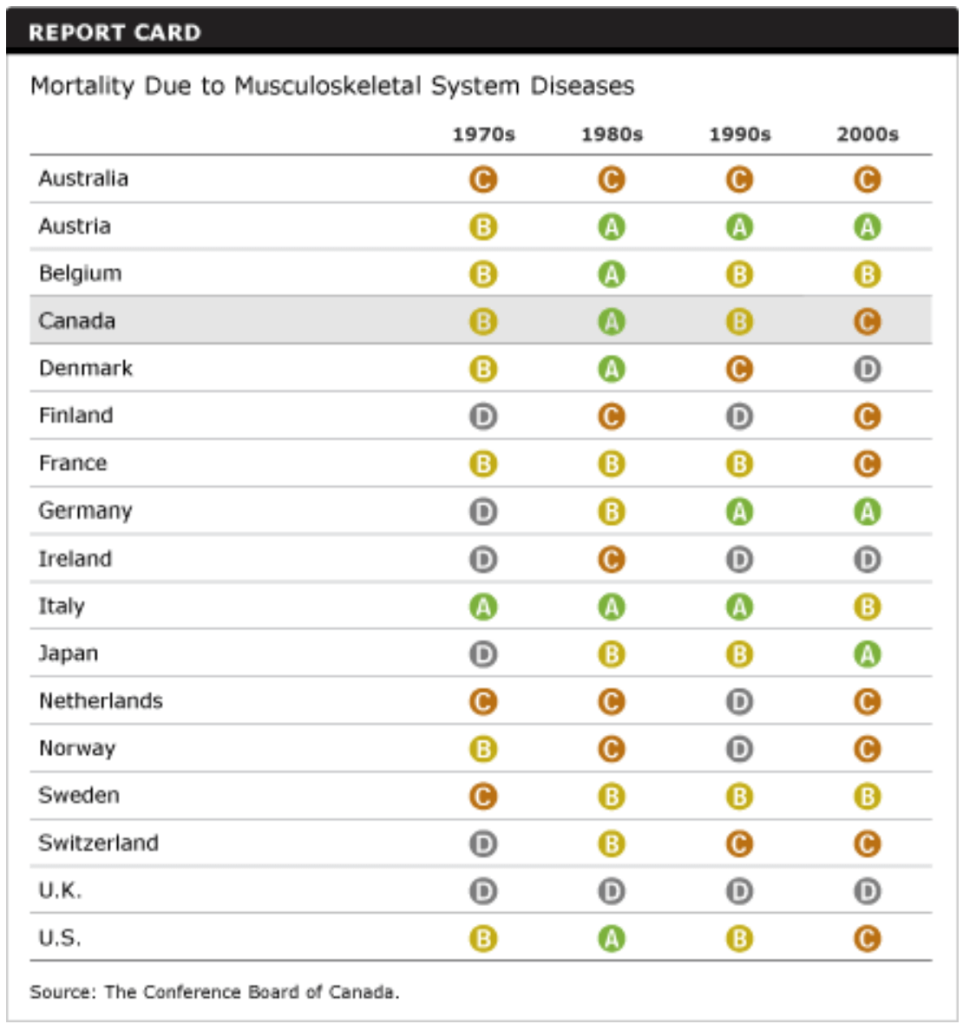Mortality Due to Diseases of the Musculoskeletal System
Key Messages
- Canada receives a “C” and drops one spot to 11th out of 17 peer countries.
- In Canada, people aged 50 and over who suffer a hip or spine fracture are at much greater risk of early death.
- The economic burden of musculoskeletal diseases is expected to increase in countries like Canada with an aging population, because the prevalence of these disorders increases with age.
Putting the mortality rate due to diseases of the musculoskeletal system in context
Many diseases that cause disability and pain are included in this category, so mortality is not really a very good indicator of the actual burden of this category of disease. Musculoskeletal disorders are the most frequent cause of physical disability for people in developed countries.1 The prevalence of musculoskeletal disorders increases with age. Internationally, musculoskeletal conditions are the most common causes of chronic disability and have increased by 25 per cent in the last 10 years.2
Musculoskeletal diseases place a huge burden on society: fractures related to osteoporosis have nearly doubled in the past decade, back pain is the second leading cause of sick leave, and joint diseases account for half of all chronic conditions in those aged 65 and over.3
The economic burden is high—in 2000, at an estimated cost of $22.3 billion, musculoskeletal diseases were the most costly condition in Canada. While the direct costs (including hospital care, physician care, and prescription drugs) of musculoskeletal diseases and injury are high, the lion’s share of costs is indirect. Three-quarters of costs for musculoskeletal diseases in Canada are indirect costs associated with lost economic productivity due to long- and short-term disability or premature death.4
In January 2000, the World Health Organization and the United Nations formally launched the Bone and Joint Decade, with the goal of improving the quality of life of those suffering from musculoskeletal diseases worldwide.5 Its mandate has since been extended for another 10 years to 2020. Its 2010–2020 strategic action plan focuses on “achieving the global objective of gaining recognition of the importance of musculoskeletal conditions globally, regionally, and nationally.”6
Have there been any notable changes in the country rankings since the last report card?
Canada now ranks 11th, dropping one spot from its 10th place showing in the last report card. This is due to the fact that data have now become available for Belgium, which places 4th among the 17 peer countries. Sweden fell from 4th place and is now tied with Italy for 6th place. Denmark drops to last place this year, behind Ireland and the United Kingdom.
How has Canada’s relative performance changed over time?

In the 1970s, Canada’s mortality rate due to diseases of the musculoskeletal system was the 6th best, earning it a “B” grade. Italy was the only “A” performer in the 1970s. It maintained its high ranking over the 1980s and 1990s but dropped to a “B” grade in the 2000s.
Canada’s grade slipped from an “A” in the 1980s back to a “B” in the 1990s, and then to a “C” in the 2000s. It now ranks 11th out of 17 peer countries.
Historically, the worst performer has been the U.K., which has earned “D” grades since the 1970s.
Are more Canadians dying of musculoskeletal diseases than in the past?
The mortality rate due to diseases of the musculoskeletal system dropped in the 1970s in Canada, then remained fairly constant until 2000, when it jumped sharply.
Japan has improved the most. Its mortality rate fell steadily, from 6 deaths per 100,000 population in 1970 to 2 deaths in 2003, where it has since remained.
Are musculoskeletal disorders going to have a greater impact on Canadians in the future?
Yes. Older people are affected more by musculoskeletal disorders such as arthritis and osteoporosis. Given that the population is aging, this means that the number of Canadians with musculoskeletal disorders will keep increasing. Not only will this reduce the quality of life of Canadians suffering from pain and disability, the increased prevalence of musculoskeletal disorders will also be costly to the Canadian economy, detracting from future productivity.
Footnotes
1 World Health Organization, The Burden of Musculoskeletal Conditions at the Start of the New Millenium, WHO Technical Report Series #919 (Geneva: WHO, 2003), 103 (accessed June 22, 2009).
2 Diseases Control Priorities Project, “Musculoskeletal Conditions Are the Most Common Cause of Chronic Disability,” May 2007 (accessed January 6, 2012).
3 Bone and Joint Decade’s Musculoskeletal Portal (accessed January 23, 2012).
4 Arthritis Community Research and Evaluation Unit, Building a Collective Policy Agenda for Musculoskeletal Health and Mobility (Toronto: Canadian Orthopaedic Care Strategy Group, Winter/Spring 2010), 7.
5 Bone and Joint Decade’s Musculoskeletal Portal (accessed January 23, 2012).
6 Bone and Joint Decade’s Musculoskeletal Portal, Bone and Joint Decade: The Next Ten Years—2010–2020 (accessed January 23, 2012).
7 George Ioannidis et al., “Relation Between Fractures and Mortality: Results from the Canadian Multicentre Osteoporosis Study,” Canadian Medical Association Journal, 181 (5), 5 (accessed September 10, 2009).
8 Ibid., 13, (accessed January 6, 2012).

